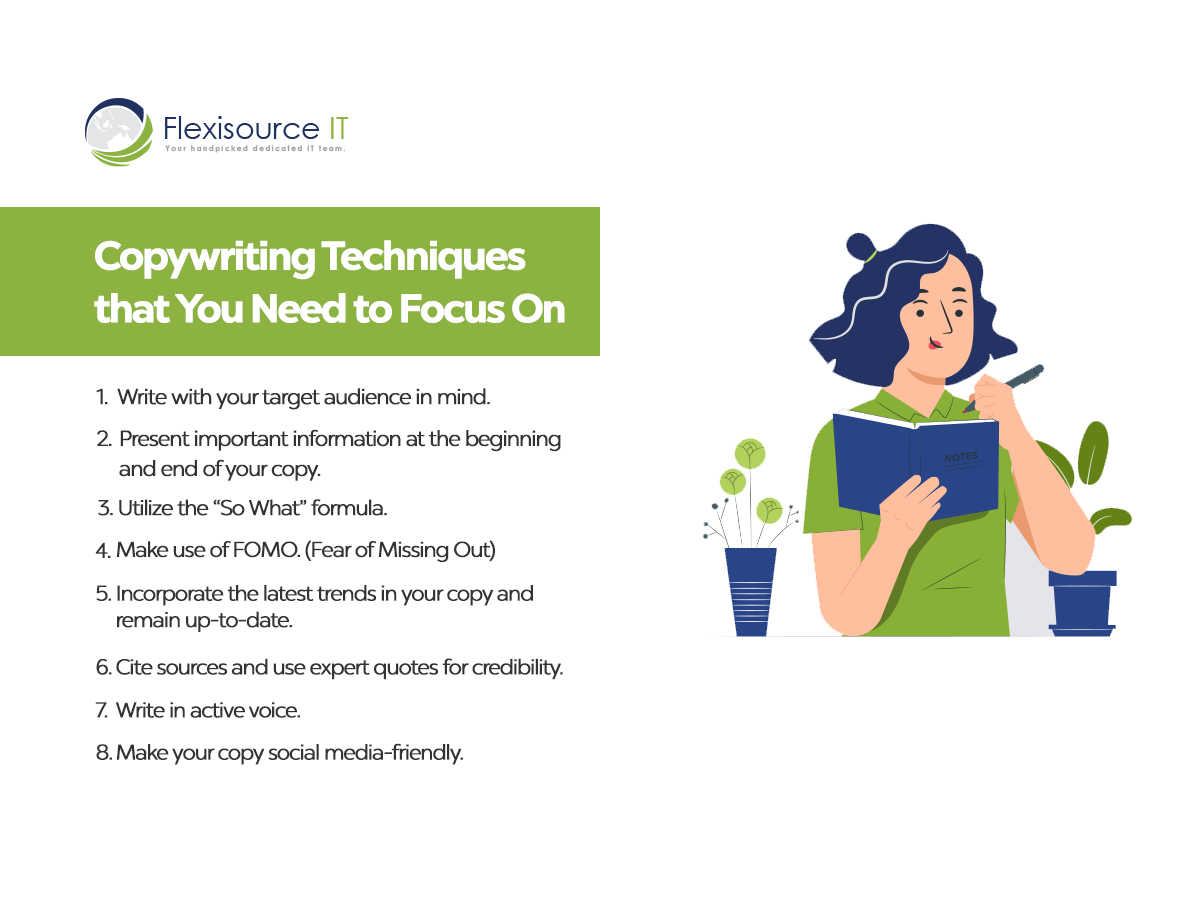Copywriting is the art of creating compelling, persuasive, and helpful text for the web, print, and other digital media. It can be a difficult skill to master, but it’s essential for any business that wants to communicate its message effectively. Effective copywriting can help increase website traffic and sales, and can even help a company win awards.
Copywriting can be split into two categories: persuasive writing and descriptive writing. Persuasive writing is used to influence a reader to take a particular action, such as buying a product or signing up for a service. Descriptive writing is used to paint a picture in the reader’s mind, such as describing an experience or explaining a concept.
Copywriters must be able to understand the target audience they’re writing for and find ways to connect with them on a personal level.
In this article, we’ll be taking a closer look at different business copywriting techniques for better conversions. So, buckle up as we delve into the art of selling your product or service without actually selling it.
Table of Contents
Write with your target audience in mind
When you sit down to write, it’s important to keep your audience in mind. You need to consider what will interest them, what will hold their attention, and how you can communicate with them in a way that is both respectful and engaging.
There are a few different techniques you can use to help you write for your target audience. One is to imagine yourself in their shoes. What would interest you? What would make you want to keep reading?
Another technique is to cater your content to their needs. Think about what they’re looking for, and give it to them straight. Be clear and concise, and avoid bombarding them with too much information at once.
Finally, it’s important to be respectful of your audience. Address them on their level, using language that they will understand.
Present important information at the beginning and end of your copy
The serial positioning effect is one of the most effective copywriting techniques. It is based on the idea that people remember the first and last things that they read in a text. This means that you should put the most important information at the beginning and end of your message.
You can use the serial positioning effect to create a powerful headline. The first sentence should be eye-catching and interesting, while the last sentence should summarize the main point of your message. You can also use it to create a strong closing argument. The last sentence should leave the reader with a clear understanding of what you want them to do.
Utilize the “So What” formula
One of the most common techniques used in copywriting is the “so what” formula. This formula can be used to create a persuasive argument by highlighting the benefits of taking action.
For example, imagine you are trying to sell a product that cleans your car. You could use the so what formula like this: “So what? Your car will look clean and shiny after using our product.” The benefits of using the product are clear. It will make your car look cleaner and shinier.
The “so what” formula can also be used to answer objections that potential customers might have.
It is important to be clear about the benefits of the product or service. It is also crucial to be concise and make sure that each point is relevant to the reader. By thinking about what the reader wants and needs, you can make content that is more convincing and effective.

Make use of FOMO
At the heart of it, copywriting is the art of persuasion. You are trying to convince someone to do something–buy a product, sign up for a service, or even just read your content. And one of the most powerful tools at your disposal is fear of missing out or FOMO.
FOMO is a very real phenomenon. It’s the fear of not being a part of something that’s important, or worse, the fear of being left out completely. And it’s a very strong motivator.
You can use FOMO in your copywriting to create a sense of urgency and encourage people to take action. For example, you could say, “Don’t miss out on this incredible opportunity” or “Act now before it’s too late.”
Another phrase that is often used with this method is “while supplies last,” which makes the customer feel like they need to act right away. Use FOMO to add urgency to your content.
Incorporate the latest trends
Copywriting is all about being in tune with the latest trends. To remain competitive, you need to be able to write copy that speaks to your audience in a way that resonates. Here are a few tips for jumping on the latest trends:
- Pay attention to what’s happening in the world around you. Keep an eye on the news, and watch for emerging trends in fashion, lifestyle, and technology.
- Get creative. Don’t be afraid to experiment with new styles and formats. Try combining different elements to create something fresh and original.
- Stay up-to-date with the latest jargon and slang. Use words and phrases that your audience is likely to be using themselves.
- Be aware of your tone and style. Be genuine, honest, and sincere. Use words that your customer is likely to understand.
- Make sure that you are setting the right tone for your brand. The tone should be consistent and clear throughout all of your marketing materials–whether it’s a newsletter, an email campaign, or a website.
Cite sources and use expert quotes for credibility
Credibility is key in copywriting. When you write, you want to make sure that your readers trust what you have to say. There are a few techniques you can use to make your content more credible:
- Use statistics and expert quotes. Back up your points with numbers or quotes from experts in the field. This will help to convince your readers that you know what you’re talking about.
- Be clear and concise. Don’t try to pad your content with fluff just to make it look longer. Keep your points clear and easy to understand, and don’t overexplain them.
- Make sure your sources are credible. When you reference other sources, make sure they are reputable and reliable.
Write in active voice
In the world of writing, there are two main types of voices: active and passive. Active voice is generally regarded as stronger, more concise, and easier to read. When using active voice, the subject of the sentence is doing the action.
For example, “The cat chases the mouse” is in the active voice. On the other hand, passive voice is weaker and can be confusing. The subject receives the action rather than doing it. For example, “The mouse was chased by the cat” is in a passive voice.
Most experts recommend using the active voice whenever possible in copywriting. It makes your writing more powerful and engaging for readers.
There are a few things to keep in mind when using active voice:
- Use strong verbs whenever possible.
- Keep sentences short and concise.
- Don’t use too many adjectives or adverbs.
- Make sure your subject and verb are in agreement.
Make your copy social media-friendly
There’s no doubt that social media has had a profound impact on the way people communicate. What began as a way for friends and family to keep in touch has turned into a powerful communications tool that can help businesses reach new customers and grow their businesses.
But, just because social media is popular doesn’t mean that businesses can take a cavalier approach to their content. In order to be successful, businesses need to create social media-friendly content that is engaging and compelling. Social media writing is a different type of beast copywriters need to conquer.
In order to create social media-friendly content, copywriters must keep a few things in mind.
First, they should make sure that their content is easy to share. This means using catchy headlines and incorporating images and videos whenever possible. They should also make sure that their content is relevant to their audience and provides value.
By following these simple tips, copywriters can create content that is sure to reach a wider audience and be popular on social media websites.
Convert more with effective business copywriting
Copywriting is an important skill to have. It can help you improve your website’s search engine ranking, increase sales, and persuade people to take action. There are many ways to improve your copywriting skills, including reading articles and books on the subject, attending writing workshops, and practicing regularly.
The tips above are just some of the ways you can start creating compelling and effective copy that will help you achieve your marketing goals.
But if you want to save time and energy while still producing quality content, nothing beats hiring a professional copywriter. Talk to us today and get connected with a strong digital marketing team that’ll do all of the heavy lifting for you.
Viel is a writer with a passion for weaving words into stories that capture the imagination and engage the public. An avid reader and enthusiastic foodie, she can often be found with a mug of coffee in hand. When she’s not writing, she loves spending time with her family and friends.



